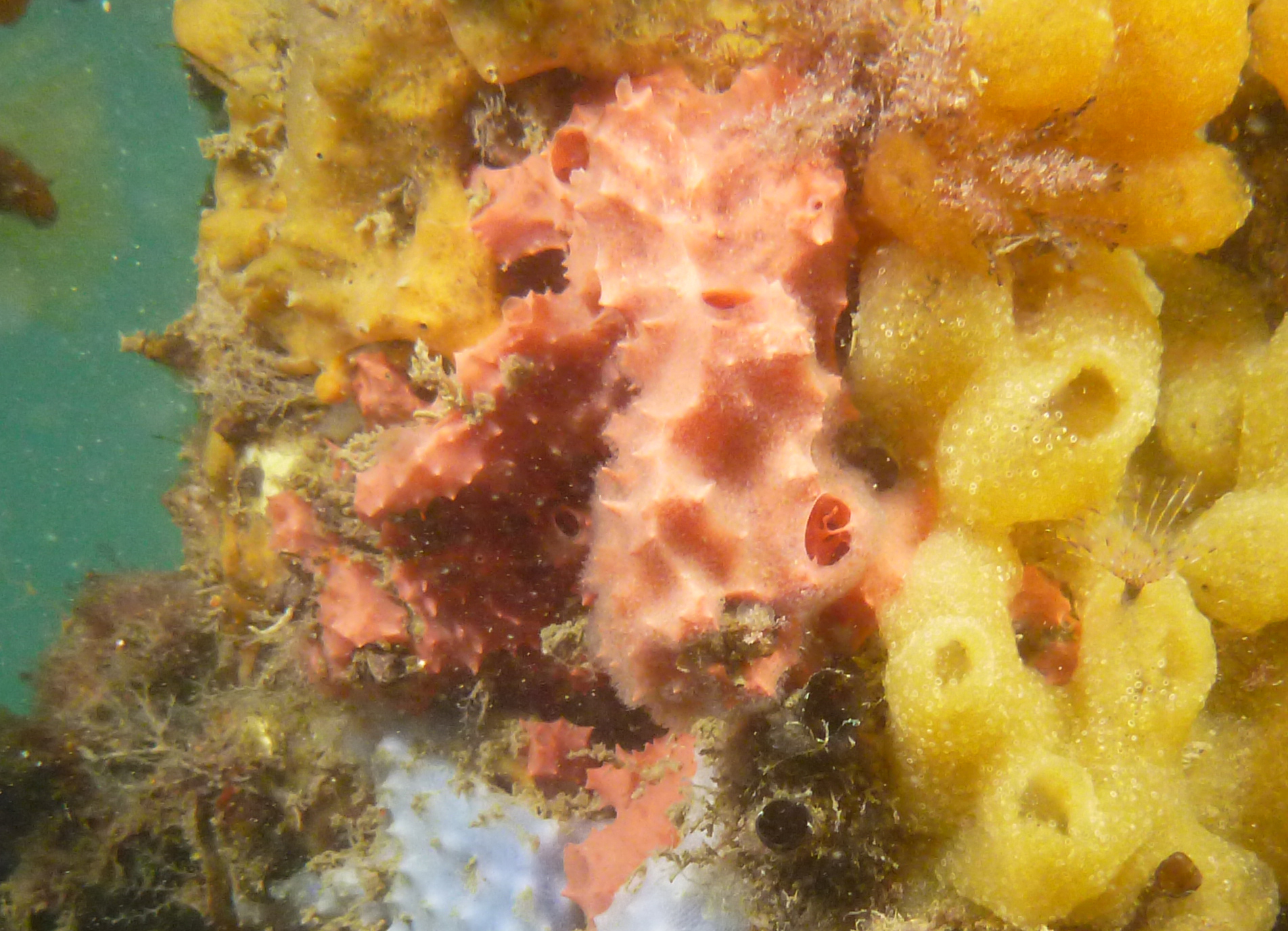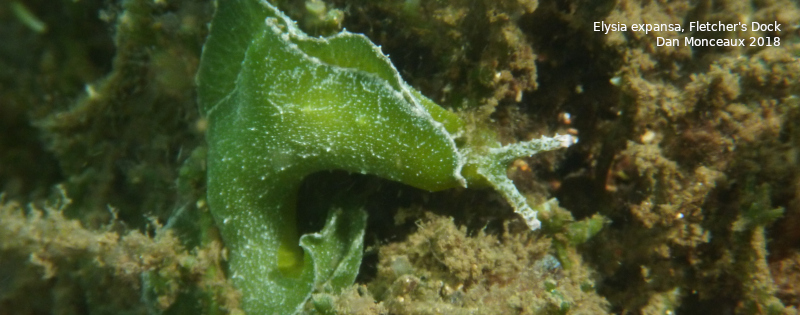I was first inspired to pay more attention to this often overlooked ecosystem by the discovery of the upside-down jellyfish, Cassiopea sp. there in 2016 by MLSSA president and area resident, Steve Reynolds.
My personal explorations soon followed, beginning at Garden Island. There, a snorkeller can easily step into the water and explore several contrasting habitats within tens of metres: the colourful jetty pile communities, life among the mangrove pneumatophores (only accessible on a high tide), subtidal Caulerpa meadows and mucky and sandy bottom in between.
In 2017 my interest in this area led to the production of several works of video art that have since shown at Gallery Yampu near the Birkenhead Bridge. A study of Cassiopea and another of a feeding anemone were produced and shown, then another piece depicting biofluorescence in anemones and crustaceans under UV light. The most recent of my videos The Raw Prawn was shot over several nights last Summer in water less than two metres deep. That piece shows the frenetic activity of prawns after dark and was also shown in the premiere edition of Underwater South Australia, a group photographic exhibition held at the City of West Torrens Auditorium Gallery in September 2018.
From art to science
More recently, I started a project on the citizen science website iNaturalist.org. My intention was to capture sighting records of marine and coastal species from across the whole estuary and inner harbor. As far as I can tell, this is a first-of-kind project for the area. It is destined to create an inventory of biodiversity which can in turn serve as a useful field guide for fellow divers, snorkellers and beachcombers.
In a few short months, that project now features the efforts of 12 observers and 56 identifiers. It contains 285 observations and 112 successfully identified species.
Surprisingly, more than half of the 285 observations are yet to be identified to species level. The groups of organisms that our tiny team has struggled to identify include a mixture of tiny crustaceans, colourful and varied ascidians (both colonial and solitary), red and green macroalgae, bryozoans, bivalves, hydrozoans, sponges, and a few small fishes.

If you have some knowledge of these groups and can help us with some IDs, here’s a link to the records that need attention. All comers are welcome but be warned: knowledge of local SA species may not be enough to help us solve many of these mini marine mysteries.
Where did I come from?
Given the Port River’s long history as the shipping channel for a busy international harbor, the origins of many species are unknown. Some of the known introduced species include the pleated sea-squirt (which has likely been established here since the age of sail) and the Mediterranean fan worm. The widely known Caulerpa taxifolia, with its bright green fern-like leaves were probably introduced to the harbor by someone emptying a tropical aquarium. The unusually warm waters of the Port River make it able to support some organisms that would not survive ambient ocean conditions here in South Australia. The warmth is due in part to stagnation in the inner harbor areas, and is exacerbated by the thermal pollution (hot water) flowing periodically from gas-fired power plants at Torrens Island and Pelican Point.

Core MLSSA members Steve Reynolds, Dave Muirhead and myself have all been surprised and intrigued by discoveries in the River and harbor. At the northern extent of Torrens Island, which is quite well flushed by tide and wind, biodiversity is noteworthy. As one explores the inner harbor, where water circulation is slower and stormwater run off and thermal pollution have more lingering effects, biodiversity is noticeably less. An extreme example of this can be found in Fletcher’s Dock, where divers and snorkellers are met by towers of introduced Ciona sp. ascidians which cover the western wall of the historic wharf.

Similarly abundant in the dock this spring are the vivid green or yellow sacoglossan sap-sucking sea slug, Elysia expansa. After discovering a substantial colony on the mucky bottom in Fletcher’s Dock on our first exploratory dive there, Steve and I chose to deposit four specimens at the South Australian Museum. Since then, I have also found them at Snapper Point and the old Quarantine Station jetty on Torrens Island. They are quite fast moving for a sea slug, and in a low visibility environment like the Port River, can be surprisingly difficult to photograph. When curled up and idle, they look remarkably similar to a fallen mangrove fruit.
What’s next?
So where to next for the project? Several readily accessible sites within West Lakes and the Inner Harbor remain ripe for exploration. The northern section of the estuary near St Kilda also remains underexplored. Steve’s and my collection work will continue.
MLSSA’s informal policy at this time is not to adversely impact populations by only taking organisms which are obviously thriving and abundant. So far, our collection efforts have included two small crustaceans: the Tiny hermit crab (Micropagurus acantholepis) which is found throughout the river and in some parts of the inner harbor, and an unknown sandy-coloured small crab with long, spindly legs (pictured). The former is abundant on sandy bottom in shallow subtidal water, and the latter is abundant in shallow meadows of Zostera seagrass between Torrens Island and Snapper Point.
On our most recent mission, Steve, Dave and I visited Torrens Island accompanied by Dominic Mcaffee from the University of Adelaide and two students. Recent MLSSA member Paul Liew also joined us, but didn’t contribute any sightings to the iNaturalist project. Dominic later advised us that his scientific efforts were well rewarded, with the successful collection and identification of dominant native fanworms, Galeolaria caespitosa. He was also surprised to find so many living (introduced) Pacific oysters forming natural reef among the mangrove pneumatophores. This was especially surprising to him, given that Pacific Oyster Mortality Syndrome or “POMs” was detected in the esturary last Summer. This resulted in oyster deaths and precautionary removals.
Special thanks must be given to Andrew Winkler of the volunteer group Friends of Torrens Island who has helped us by providing access to the shore at the Quarantine Station site via the Torrens Island power station complex.
As Summer approaches, I invite any interested readers to upload some of their own sightings to our iNaturalist project. It’s free and easy and will help inform our scientific understanding of the Port River’s waters and their future management.

